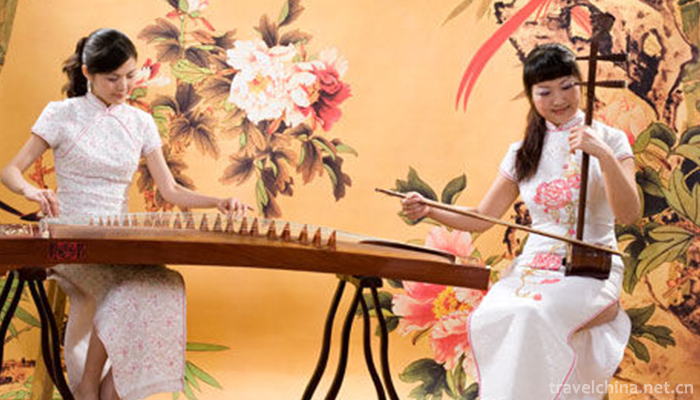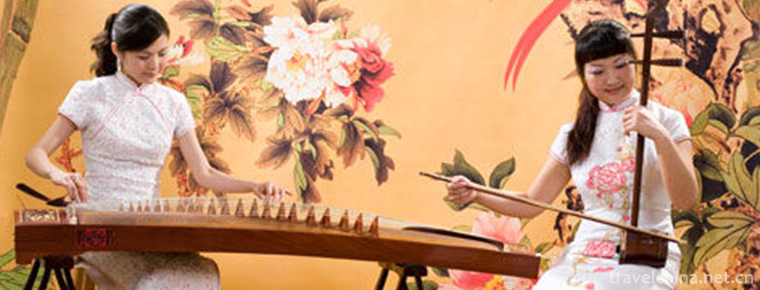String Music Heze String Music
String Music Heze String Music
Heze string music is one of the second batch of national intangible cultural heritage announced by the State Council. It is a well-known traditional folk music in southwestern Shandong Province, and it is popular in Heze and Heze surrounding areas. Heze string music has a long history, elegant style and elegant music.
origin
Heze string music has a long history, elegant style and elegant music. It is mainly distributed in the villages of Yuncheng and Juancheng counties in Heze City. Usually it is played by four kinds of silk string instruments: Zheng, Pipa, Yangqin and Ruyigong. It can also be played only by Zheng and Yangqin, or by Zheng and Yangqin, Pipa, or by soft bow Hu, Yuanhu and Erhu. The flexible combination and free collocation of musical instruments can be said to be the oriental folk symphony.
perform
In Heze, string-rope music is a way for folk artists to entertain themselves. It can be played in temples, family courtyards and other places during temple fairs, holidays or winter leisure. The metropolis plays two or three instruments and can play other instruments when it is short of hands.
Heze string music has ten sets of ancient music, each of which is a set of Yeba Ban. Artists call it "touching eight boards". Because each of the eight phrases of the song has eight boards, the whole song has four boards in addition to the structure. It is called "Ye 68 board" and "Touch 8 board". The instruments used constitute different parts of the voice.
The melodies of these voices are derived from the eighth slab of the mother curly leaves. So we can collide wildly and form a unified and harmonious whole. The melody of Heze string music is elegant and melodious, and the harmony is melodious and melodious. It has both antique style and distinct local color.


-
1.Island Jinshan Temple
Jinshan Temple, located in the northern part of Qingyun County, Dezhou City, Shandong Province, was built in the Sui Dynasty and flourished in the Tang Dynasty. It is said that the island Jinshan Temp
Time 2019-01-13 -
2.Kuqa Wangfu Scenic Area
Located in Kuqa County, Xinjiang, the "Kuqa Wangfu" was built by Emperor Qianlong of Qing Dynasty in 1759 by dispatching Han craftsmen from the mainland in order to commend the local Uygur l
Time 2019-01-29 -
3.Liao Zhai City
Liaozhai City was invested and built by Pujiazhuang, Zichuan. It is a large-scale famous garden scenic area with gardens as its manifestation and Liaozhai stories as its theme
Time 2019-01-30 -
4.Yimeng Red Film and Television Base
Yimeng Red Film and Television Base, located in Changshan Villa, Ma Muchi Township, Yinan County, Linyi City, Shandong Province, was built in 2009. It is a comprehensive tourist area
Time 2019-03-03 -
5.Tibetan Engraving and Printing Techniques
Tibetan engraving and printing skills of Dege Printing Institute, local traditional handicraft skills of Dege County, Sichuan Province, and one of the national intangible cultural heritages.
Time 2019-04-05 -
6.Scissors Forging Technology
Zhang Xiaoquan scissors forging technology, local traditional handicraft in Hangzhou, Zhejiang Province, one of the national intangible cultural heritage.
Time 2019-05-05 -
7.Maonan people beat monkey drum
"Monkey Drum Dance" is a traditional dance of Maonan nationality in Guizhou Province, which is used for funeral activities and performed by wizards. It is spread in some villages of Pingtang
Time 2019-05-26 -
8.Uygur Daolang Maxi Refu
Maigaiti County is located in the southwest of Xinjiang Uygur Autonomous Region. It is a typical Uygur inhabited area. About 89% of the population is Daolang Uygur who can sing and dance well. Among t
Time 2019-06-26 -
9.Proverbs Shanghai Proverbs
Shanghai proverb, also known as Shanghai proverb, is the traditional folk oral literature in Shanghai. Local gossip. It belongs to one of the national intangible heritage.
Time 2019-07-10 -
10.Cao Cao
Wei Wu Di Cao Cao (155 years - 220 March 15th), the name is Geely, the word Meng De, nicknamed hide. Prefectural governor of Yuzhou Qiao (today) Anhui Bozhou Person . Eastern Han Dynasty Outstanding i
Time 2019-09-07 -
11.Climate of Luzhou
Luzhou city belongs to subtropical humid climate zone, and the three-dimensional climate is obvious in the southern mountainous area. It has high temperature, sufficient sunshine, abundant rainfall, four distinct seasons, long frost free period, temperature, light and water in the same season
Time 2020-12-14 -
12.Administrative division of Nanchong
Nanchong City governs nine county-level administrative divisions (Municipal District 3, county-level city 1, county-level 5), and 241 township level administrative divisions (street 42, town 161, township 38). It covers an area of 12514 square kilometers and has a population
Time 2020-12-17